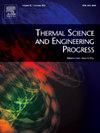MHD - Prandtl混合纳米流体通过指数拉伸多孔装置的热辐射和耗散效应研究
IF 5.1
3区 工程技术
Q2 ENERGY & FUELS
引用次数: 0
摘要
流体动力学要求对能量耗散、传热和传质现象有全面的了解,因为它直接影响到各种工业和工程应用中的热效率、流动稳定性和节能。基于这一动机,本研究研究了普朗特混合纳米流体在指数拉伸表面上的磁化流动。混合纳米流体是由二氧化钛(TiO2)和铜(Cu)纳米颗粒在水中作为基液形成的。控制方程组是作为普朗特流体模型的扩展而制定的,用于研究化学过程、热辐射、生物对流和能量耗散的物理效应。通过对控制方程进行适当的变换,推导出非线性常微分方程,并采用微分变换法对其进行数值求解。通过MATLAB得到无量纲速度、温度和浓度的图形说明,并对磁参数、化学反应、辐射参数、Sherwood数、Nusselt数、摩擦参数等各项进行了适当的物理论证。通过与先前发表的工作的比较,验证了结果。结果表明,与常规纳米流体相比,混合纳米流体显著提高了换热效率。增加埃克特数和比奥数会提高温度,而更强的磁场会降低流体速度。增加磁参数可使速度降低42% (NF)和37.5% (HNF),而增加Eckert数可使温度升高67% (NF)和53% (HNF),突出了强磁和粘性耗散效应。该研究结果在石油开采、换热器优化和MHD推进系统中具有重要的应用价值,其中能量耗散和热辐射起着至关重要的作用。本文章由计算机程序翻译,如有差异,请以英文原文为准。
Study of thermal radiation and dissipation effects on MHD Prandtl hybrid nanofluid flow past an exponential stretched porous device
Fluid dynamics requires a comprehensive understanding of energy dissipation, heat and mass transfer phenomena, since it directly impacts thermal efficiency, flow stability, and energy conservation in various industrial and engineering applications. With this motivation, the present study investigates the magnetized flow of Prandtl mixed hybrid nanofluids across an exponentially stretched surface. The hybrid nanofluid is formed with nanoparticles of Titanium oxide (TiO2) and Copper (Cu) in water as the base fluid. The governing set of equations is formulated as an extension of the Prandtl fluid model to investigate the physical effects of chemical processes, heat radiation, bioconvection, and energy dissipation. The nonlinear ordinary differential equations are derived after successfully implementing appropriate transformations on governing equations and are solved numerically via the Differential Transform Method (DTM). The graphical illustration of non-dimensional velocity, temperature, and concentration is obtained through MATLAB and discussed with proper physical justification for various terms such as magnetic parameter, chemical reaction, radiation parameter, Sherwood number, Nusselt number, and friction parameter. The outcomes are validated with a comparison of previous published work. Results reveal that hybrid nanofluids significantly enhance heat transfer efficiency compared to conventional nanofluids. Increasing the Eckert and Biot numbers raises temperature, while a stronger magnetic field reduces fluid velocity. Increasing magnetic parameter reduces velocity by 42 % (NF) and 37.5 % (HNF), while increasing Eckert number raises temperature by 67 % (NF) and 53 % (HNF), highlighting strong magnetic and viscous dissipation effects. The findings of this study have significant applications in oil extraction, heat exchanger optimization, and MHD propulsion systems, where energy dissipation and thermal radiation play a crucial role.
求助全文
通过发布文献求助,成功后即可免费获取论文全文。
去求助
来源期刊

Thermal Science and Engineering Progress
Chemical Engineering-Fluid Flow and Transfer Processes
CiteScore
7.20
自引率
10.40%
发文量
327
审稿时长
41 days
期刊介绍:
Thermal Science and Engineering Progress (TSEP) publishes original, high-quality research articles that span activities ranging from fundamental scientific research and discussion of the more controversial thermodynamic theories, to developments in thermal engineering that are in many instances examples of the way scientists and engineers are addressing the challenges facing a growing population – smart cities and global warming – maximising thermodynamic efficiencies and minimising all heat losses. It is intended that these will be of current relevance and interest to industry, academia and other practitioners. It is evident that many specialised journals in thermal and, to some extent, in fluid disciplines tend to focus on topics that can be classified as fundamental in nature, or are ‘applied’ and near-market. Thermal Science and Engineering Progress will bridge the gap between these two areas, allowing authors to make an easy choice, should they or a journal editor feel that their papers are ‘out of scope’ when considering other journals. The range of topics covered by Thermal Science and Engineering Progress addresses the rapid rate of development being made in thermal transfer processes as they affect traditional fields, and important growth in the topical research areas of aerospace, thermal biological and medical systems, electronics and nano-technologies, renewable energy systems, food production (including agriculture), and the need to minimise man-made thermal impacts on climate change. Review articles on appropriate topics for TSEP are encouraged, although until TSEP is fully established, these will be limited in number. Before submitting such articles, please contact one of the Editors, or a member of the Editorial Advisory Board with an outline of your proposal and your expertise in the area of your review.
 求助内容:
求助内容: 应助结果提醒方式:
应助结果提醒方式:


